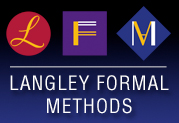DANTi
Detect and Avoid in the Cockpit (DANTi) is a research effort that includes concept development, prototype implementation, system integration, and flight testing of NASA-developed assistive detect and avoid (DAA) technology in manned aircraft cockpits.
The notion of assistive DAA for manned aviation proposes the use of DAA technology to provide pilots traffic awareness and maneuver guidance support when required to comply with see and avoid regulations. That is, DANTi serves as a safety augmentation to pilots' see-and-avoid capabilities, rather than a replacement of see-and-avoid capabilities as in DAA for UAS. Assistive DAA technologies can be integrated into today's cockpit as "Non-Required Safety Enhancing Equipment" (NORSEE), as stated in the FAA Policy No:PS-AIR-21.8-1602, which describes a standardized approval process of NORSEE in general aviation and rotorcraft fleets.
A prototype implementation of a DANTi display has been developed that uses the DAIDALUS algorithm for generating alerts and maneuver guidance. DAIDALUS is the reference implementation for the DAA Minimum Operational Performance Standards (MOPS) document DO-365, DO365A, and DO365B developed by the RTCA Special Committee SC228. Preliminary simulation results obtained with the DANTi prototype strongly suggest that assistive DAA could greatly enhance the capabilities of flight crews to avoid traffic and remain well clear.
DANTi is available under NASA's Open Source Agreement from GitHub![[*]](/images/exlink.gif) .
A desktop version of DANTi is also available for download with DAA-Displays, a NASA-developed open-source toolkit designed to support research on DAA technologies.
.
A desktop version of DANTi is also available for download with DAA-Displays, a NASA-developed open-source toolkit designed to support research on DAA technologies.
Publications
- James Chamberlain, Maria Consiglio,
César Muñoz, and Paolo Masci,
Assistive detect and avoid technology in urban air mobility environments,
Proceedings of the 43rd Digital Avionics Systems Conference (DASC 2024),
September-October 2024, San Diego, CA, USA
![[*]](/images/exlink.gif) . BibTeX
Reference.
. BibTeX
Reference.
- Paolo Masci, James Chamberlain, César Muñoz, and
Maria Consiglio,
DANTi: A tool for assistive detect and avoid research,
Proceedings of the 43rd Digital Avionics Systems Conference (DASC 2024),
September-October 2024, San Diego, CA, USA
![[*]](/images/exlink.gif) . BibTeX
Reference.
. BibTeX
Reference.
- Víctor Carreño, ATM-X Urban Air Mobility: Assistive Detect and Avoid for UAM Operations Safety Evaluation Metrics, Contractor Report, NASA/CR-20230013203, December 2023. BibTeX Reference.
-
Víctor Carreño, Paolo Masci, Maria Consiglio,
Assistive Detect-and-Avoid for Pilots in the Cockpit,
Proceedings of the 41st Digital Avionics Systems Conference (DASC),
September 2022, Portsmouth, VA, USA
 . BibTeX
Reference.
. BibTeX
Reference.
- Víctor Carreño, Evaluation, Analysis and Results of the DANTi Flight Test Data, the DAIDALUS Detect and Avoid Algorithm, and the DANTi Concept for Detect and Avoid in the Cockpit, Contractor Report, NASA/CR-20205004594, August 2020. BibTeX Reference.
- James Chamberlain, María Consiglio, and César Muñoz DANTi: Detect and Avoid iN The Cockpit, Proceedings of the 17th AIAA Aviation Technology, Integration, and Operations Conference (ATIO 2017), AIAA-2017-4491, 2017. BibTeX Reference.
Talks
- Víctor Carreño, Potential of Detect and Avoid in the Flight Deck to Mitigate Collision Risk, August 2021.
Additional Resources
Project Contacts
- Maria Consiglio, NASA Langley Research Center
- César Muñoz, NASA Langley Research Center
- Paolo Masci, AMA Inc @ NASA LaRC
The tag
![[*]](../../images/exlink.gif) identifies links that are outside
the NASA domain
identifies links that are outside
the NASA domain




